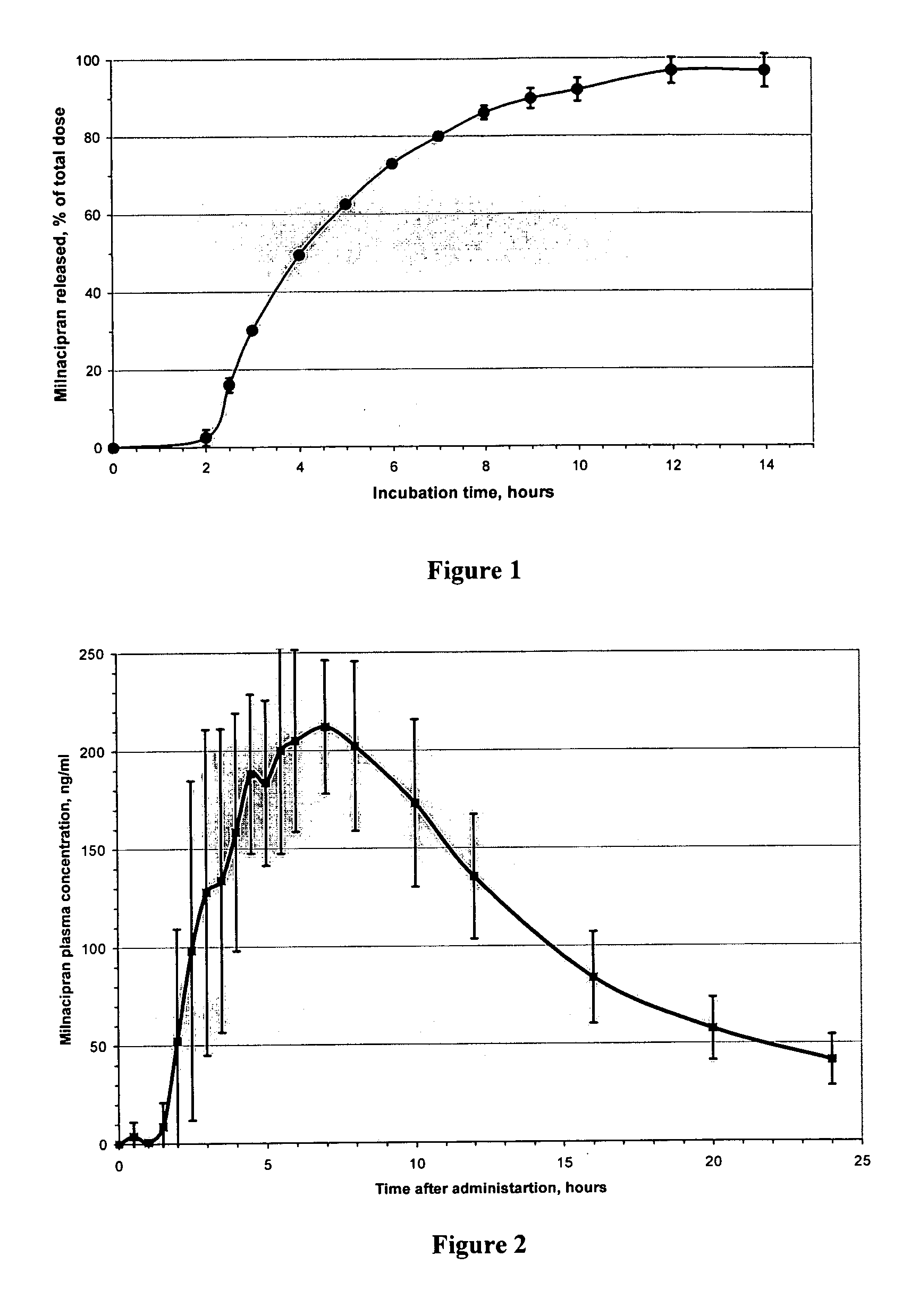Modified release compositions of milnacipran
- Summary
- Abstract
- Description
- Claims
- Application Information
AI Technical Summary
Benefits of technology
Problems solved by technology
Method used
Image
Examples
example 1
Preparation of a Delayed Release / Extended Release Milnacipran Tablet Using Aqueous Granulation
[0093] The ingredients, manufacturing process, and in vitro dissolution data for the extended release portion of a delayed release / extended release milnacipran pharmaceutical composition are described below (Lot# 1, small scale manual batch):
INGREDIENTSmg per tabletMilnacipran HCl120Hydroxypropyl150Methylcellulose E10MEthyl cellulose 10 cps70Dibasic Calcium100phosphate, DihydratePovidone K 908Magnesium stearate6Total tablet weight454
[0094] A wet granulation process consisting of the steps of dry blending, wet granulation, drying, size reduction, and final blending with a lubricant was utilized on a bench scale. The tablets were compressed using a single station bench top model tablet press.
[0095] Dissolution in Phosphate Buffer pH 6.8
Dissolution time,0.51246810121416hoursMilnacipran released,19273853637176808285% of total dose
[0096] A USP dissolution apparatus I (rotating baskets at 10...
example 2
Preparation of an Alternative Delayed Release / Extended Release Milnacipran Tablet Using Alcohol Granulation
[0097] The ingredients, manufacturing process, and in vitro dissolution data for the extended release portion of an alternative delayed release / extended release milnacipran pharmaceutical composition are described below (Lot# 2, small scale manual batch).
INGREDIENTSmg per tabletMilnacipran HCl200Lactose150Hydroxypropyl150methylcelluloseK15MPovidone K 9010Magnesium stearate5Total tablet weight515
[0098] The wet granulation process was performed as described in Example 1, only alcohol was used for wet granulation step. The tablets were compressed using a single station bench top model tablet press.
[0099] Dissolution in Deionized (“DI”) Water
Dissolution time,0.512468101214hoursMilnacipran released, % of142233485967727685total dose
[0100] A USP dissolution apparatus I (rotating baskets at 100 rpm) filled with deionized (“DI”) water was used for the dissolution experiments. Expe...
example 3
Preparation of a Delayed Release / Extended Release Milnacipran Tablet Using Aqueous Granulation
[0101] The ingredients, manufacturing process, and in vitro dissolution data for the extended release portion of a delayed release / extended release milnacipran pharmaceutical composition are described below (Lot Nos. 3 and 6, small scale manual batches; Lots Nos. 4 and 5, laboratory equipment scale):
Lot# 3 -Lot# 4 -Lot# 5 -Lot# 6 -INGREDIENTSbenchlab-equiplab-equipbenchMilnacipran HCl120mg120mg120mg120mgHydroxypropyl80mg150mg150mgMethylcellulose K100MHydroxypropyl80mg150mgMethylcellulose E10MDibasic Calcium150mg118mg98mgphosphate, DihydrateLactose, Anhydrous98mgEthocel ® 10 cps52mg52mg52mgPovidone K 908mg8mgAquacoat ® 30D3.7mg5.7mgMagnesium stearate6mg6mg6mg6mgTotal tablet weight444mg454mg429.7mg431.7mg
[0102] The wet granulation process was performed as described in Example 1. The tablets were compressed using a single station bench top model tablet press.
[0103] Dissolution in Phosphate...
PUM
| Property | Measurement | Unit |
|---|---|---|
| Fraction | aaaaa | aaaaa |
| Fraction | aaaaa | aaaaa |
| Time | aaaaa | aaaaa |
Abstract
Description
Claims
Application Information
 Login to View More
Login to View More - R&D
- Intellectual Property
- Life Sciences
- Materials
- Tech Scout
- Unparalleled Data Quality
- Higher Quality Content
- 60% Fewer Hallucinations
Browse by: Latest US Patents, China's latest patents, Technical Efficacy Thesaurus, Application Domain, Technology Topic, Popular Technical Reports.
© 2025 PatSnap. All rights reserved.Legal|Privacy policy|Modern Slavery Act Transparency Statement|Sitemap|About US| Contact US: help@patsnap.com

